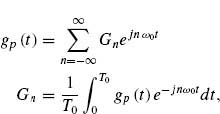2
DISCRETE TIME AND FREQUENCY TRANSFORMATION
This chapter addresses discrete signal transformations in both time and frequency domains. The relationship between continuous and discrete Fourier transform is discussed in Section 2.1. Section 2.2 reviews several key properties of discrete Fourier transform. The effect of Window functions on discrete Fourier transform is described in Section 2.3, and fast discrete Fourier transform techniques are covered in Section 2.4. The discrete cosine transform is reviewed in Section 2.5. Finally, the relationship between continuous and discrete signals in both time and frequency domains is illustrated graphically with an example in Section 2.6.
2.1 CONTINUOUS AND DISCRETE FOURIER TRANSFORM
It was shown in Chapter 1 that a periodic signal gp(t) can be expressed as

where T0 is the period of g(t), and

It also was shown that gp(t) can be represented in terms of Fourier series coefficients as

where ω0 = 2π/T0.
Now, let t = n ΔT and τ = N1 ΔT, where ΔT = 1/fs, and fs is the sampling frequency that satisfies the Nyquist requirement. Assume that all frequencies are normalized with respect to fs, or fs = 1. Then t = nΔT = n, T0 = NΔT = N, τ = N1ΔT = N1
Get Digital Signal Processing Techniques and Applications in Radar Image Processing now with the O’Reilly learning platform.
O’Reilly members experience books, live events, courses curated by job role, and more from O’Reilly and nearly 200 top publishers.

